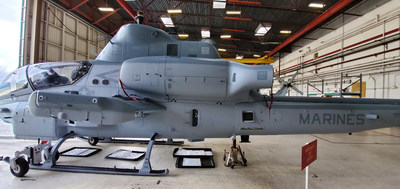WASHINGTON, June 5, 2019 /PRNewswire/ -- The U.S. Naval Research Laboratory's Center for Corrosion Science and Engineering developed a safer and user-friendly topcoat that was recently applied onto the exterior of Navy and Marine Corps aircraft.

The topcoat, which is a one-component (1K) polysiloxane based on organosilane polymers, is a new technology that is free of harmful isocyanates and other hazardous air polluting (HAP) chemicals. Isocyanates and HAPs are found in two-component (2K) polyurethane topcoats currently used on Department of Defense (DoD) and commercial aircraft.
Erick Iezzi, Ph.D., senior research chemist at NRL, and engineers at Naval Air Warfare Center – Aircraft Division, applied the new topcoat onto a U.S. Navy F/A-18 Hornet located at Naval Air Station Patuxent River, Maryland. Additionally, the 1K topcoat was applied on Marine Corps UH-1Y Venom and AH-1Z Viper helicopters located at Marine Corps Air Station New River, Jacksonville, North Carolina and Marine Corps Base Camp Pendleton, California, respectively.
The 1K polysiloxane topcoat on these aircraft is scheduled for a 1 to 2-year evaluation period.
"We're very proud of this achievement," Iezzi said. "Polyurethane topcoats have existed for several decades, yet within a few years we've been able develop an environmentally friendly alternative that provides similar laboratory performance and is easy for painters to use."
According to the Occupational Safety and Health Administration, or OSHA, exposure to isocyanates can result in irritation of the skin and mucous membranes, chest tightness, and difficulty breathing, and HAPs are classified as potential human carcinogens. Isocyanate exposure can also cause sensitization, resulting in severe asthma attacks upon subsequent exposures at even low levels.
Replacing isocyanates with polysiloxane provides a safer coating for painters and anyone conducting maintenance in nearby areas. The new 1K topcoat also contains lower levels of volatile organic compounds, which negatively impact air quality when released during spray applications.
The 1K polysiloxane topcoat requires no metering or mixing of components because all chemicals are in a single container, thereby reducing time of preparation and providing a more homogeneous color on aircraft. The container is also resealable for future use, which reduces the generation of hazardous waste and disposal costs.
Iezzi and other NRL chemists previously developed coatings for surface ships, but the requirements for aircraft coatings are more demanding.
"Developing a new high-performance topcoat for aircraft is more difficult than for ships," Iezzi said. "Aircraft have aluminum skin, which means the coating must provide greater flexibility, especially at cold temperatures during high-altitude flight. An aircraft topcoat must also retain a camouflage appearance for longer periods of time."
As part of NRL's large patent portfolio, the polymers and polysiloxane coating technology are covered by U.S. Patents 9139753, 9701868, and 10190020. The first two patents are partially exclusively licensed by NCP Coatings, Inc. of Niles, Michigan, which produces the camouflage topcoat for demonstrations and field validation. NCP Coatings is also using this technology to develop semi- and high-gloss formulations for aircraft.
These topcoat applications were coordinated with the Naval Air Systems Command and sponsored by the Defense Department's Environmental Security Technology Certification Program (ESTCP) with contributing funds from the Office of Naval Research (ONR).
The U.S. Naval Research Laboratory provides the advanced scientific capabilities required to bolster our country's position of global naval leadership. With more than 2,500 personnel scientists, engineers and support staff, it has served the U.S. Navy and the nation for nearly 100 years, advancing research further than you can imagine. For more information, visit the NRL website and join the conversation on Twitter, Facebook, and YouTube.
Editor Contact: Victor Chen, U.S. Naval Research Laboratory Public Affairs
victor.chen@nrl.navy.mil
202-767-2326
SOURCE The U.S. Naval Research Laboratory
© 2024 Benzinga.com. Benzinga does not provide investment advice. All rights reserved.
Trade confidently with insights and alerts from analyst ratings, free reports and breaking news that affects the stocks you care about.